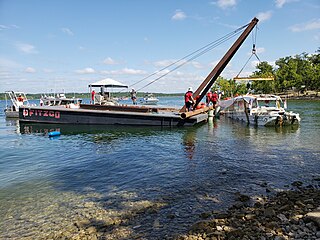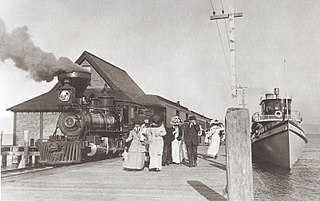 W
WOn March 22, 2014, a boat traveling on Africa's Lake Albert capsized. According to local police, 45 survivors were rescued. Officially, 251 people died in the accident.
 W
WA. J. Goddard was a Klondike Gold Rush era sternwheeler owned by Seattle businessman Albert J. Goddard and built for transport of men and supplies on the Upper Yukon River in Canada. She was assembled from pieces which were manufactured in San Francisco, shipped up to Skagway, Alaska, hauled over the Coast Mountains, and finally assembled at Lake Bennett. She made one trip to Dawson during the gold rush, was sold and sank in a storm on Lake Laberge in 1901. Her wreck was discovered in 2008 by Doug Davidge and was designated as a Yukon Historic Site.
 W
WThe first USS Barataria was a steamer captured by the Union Army during the American Civil War. She was used by the Union Navy as a gunboat in support of the Union Navy blockade of Confederate waterways.
 W
WThe Bull-of-the-Woods Logging Scow is a small paddle steamer wrecked in Burntside Lake in Morse Township, Minnesota, United States. It was built no earlier than 1893 for one of the lumber companies operating in the area. It is a small, flat-bottomed vessel outfitted with a steam donkey modified to power the vessel as well as a winch. There were at least a few of these vessels in operation in northeastern Minnesota in the late 19th and early 20th centuries, where they were locally known as "alligators" or "gators". With the steam-powered winch and shallow paddle wheels, they could tow timber rafts, hoist logs, navigate shallow waters, and even pull themselves across dry land. This vessel may have remained in service as late as 1926, when the last lumber company ceased operations on Burntside Lake. It is the only known surviving example of its type.
 W
WThe Cadet shipwreck is an archaeological site located in Lake George near Bolton in Warren County, New York. It is the site of the shipwreck of the 1893-built Olive ex Cadet steam launch. It was a 48-foot-long, 9.6-foot-wide wooden steamboat with a pointed bow, and was found submerged in approximately 50 feet of water. The ship was discovered by Bateaux Below Inc. in 1997. In 2005, the ship was reported to be in fairly good condition, with its hull mainly intact.
 W
WThe steamboat Oakes Ames was built in 1868 by the Napoleon B Proctor Shipyard in Burlington, Vermont for the Rutland Railroad. The 244-foot paddle wheeler was designed to ferry railroad cars from Burlington across Lake Champlain to Plattsburgh, New York. She was named after one of the railroad's directors' Oakes Ames.
 W
WThe Ethan Allen was a 40-foot, glass-enclosed tour boat operated by Shoreline Cruises on Lake George in upstate New York. On October 2, 2005, at 2:55 p.m., with 47 passengers—all from Michigan and Ohio and mostly seniors—aboard, the Ethan Allen capsized and sank just south of Cramer Point in the Town of Lake George. Twenty passengers died. The accident caused government regulators to consider new laws on passenger boat capacity.
 W
WThe shipwreck site of the motor launch Forward is located in Lake George, New York approximately three and one half miles north of the village of Lake George. The motor launch was built in 1906 by Gas Engine & Power Co. and Charles L. Seabury & Co., Consolidated. It was one of the first gasoline-powered vessels on Lake George. The original owner was William K. Bixby.
 W
WSF Hydro was a Norwegian steam powered railway ferry that operated in the first half of the 20th century on Lake Tinn in Telemark. It connected with the Rjukan Line and Tinnoset Line, at Mæl and Tinnoset, operating between 1914 and 1944. The combined track and ferry service was primarily used to transport raw materials and fertilizer from Norsk Hydro's factory at Rjukan to the port in Skien. It was the target of a Norwegian operation on 20 February 1944, when resistance fighters sank the ferry in the deepest part of Lake Tinn in order to prevent Nazi Germany from receiving heavy water.
 W
WThe Land Tortoise was a military transport ship built for service on Lake George, New York during the French and Indian War. The vessel, a radeau (raft), was built in 1758, and was intentionally sunk later that year with the intention of raising her for use in 1759. This did not happen, and the sunken vessel was discovered in 1990. Its site is a National Historic Landmark and a state-protected underwater preserve. It is believed to be the oldest intact warship in North America, and is the only surviving ship of its type. The site is accessible to the diving public with advanced diving skills.
 W
WThe Nemi ships were two ships, one larger than the other, built under the reign of the Roman emperor Caligula in the 1st century AD at Lake Nemi. Although the purpose of the ships is only speculated upon, the larger ship was essentially an elaborate floating palace, which contained quantities of marble, mosaic floors, heating and plumbing and amenities such as baths. Both ships featured technology thought to have been developed historically much later. It has been stated that the emperor was influenced by the lavish lifestyles of the Hellenistic rulers of Syracuse and Ptolemaic Egypt. Recovered from the lake bed in 1929, the ships were destroyed by fire during World War II in 1944.
 W
WSS Robert Coryndon was a British twin-screw passenger and cargo ferry on Lake Albert in central Africa.
 W
WMV Sinar Bangun sank on 18 June 2018 in Lake Toba, North Sumatra, Indonesia, during its trip from Simanindo Harbour in Samosir Island to Tiga Ras Harbour in Simalungun Regency. The ferry was carrying 188 passengers and crew. After the sinking, authorities immediately deployed search and rescue personnel to the area. Twenty-one survivors were rescued, three bodies were found and 164 people were listed as missing and presumed dead.
 W
WOn the evening of July 19, 2018, a duck boat operated by Ride the Ducks sank on Table Rock Lake in the Ozarks near Branson, Missouri, in the United States. The amphibious vehicle sank with 31 people on board, leaving 17 dead, during high winds associated with nearby severe thunderstorms.
 W
WSS Tahoe was a steamship that operated on Lake Tahoe at the end of the 19th century and first half of the 20th. Scuttled in 1940, the wreck presently lies in 400 feet (120 m) of water off Glenbrook, Nevada. The wreck was first visited in 2002 by a team from New Millennium Dive Expeditions (NMDE) in a record-setting high-altitude dive for Lake Tahoe. As a result of the work that NMDE did on the Tahoe site from 1999 up to their dives in 2002, Tahoe became the first maritime site in Nevada to be listed in the National Register of Historic Places.
 W
WThe Thekkady boat disaster occurred on 30 September 2009, when the double-decker passenger boat Jalakanyaka sank in Lake Thekkady, Periyar National Park, Kerala, India. When the boat capsized, 45 tourists died, most of them from Delhi and Kolkata. A total of 82 people were on the boat. The boat's helmsman, Victor Samuel, and another crew member were arrested on 5 October.
 W
WThe Wiawaka bateaux are a cluster of shipwrecks in Lake George, New York State. The seven British and colonial bateaux were scuttled in 1758 during the French and Indian Wars, with the intention of recovery in 1759. This never happened, and their wrecks were discovered between 1963 and 1964 by archaeological diver Terry Crandall, working under the auspices of the Adirondack Museum. The site was listed on the National Register of Historic Places in 1992.